All leading brands conclude that success means enhanced customer experience and not aggressive sales. Omnichannel marketing with personalized experiences enables exactly this. We are way past the time when you could bombard users with ads and promotional content on multiple channels and expect them to convert. Brands need to nurture users and deliver value consistently.
Each interaction needs to be personalized and acknowledge the user’s journey across all touchpoints. There are at least 7 communication channels that a brand uses to reach its customers. A consistent and unified customer experience maximizes engagement potential, and omnichannel marketing does that.
It comes as no surprise that it has become an important primary growth driver of major global companies.
But what exactly is omnichannel marketing? Why does your business need it? How do you create a robust omnichannel marketing strategy? And finally, some examples with case studies–we’ll discuss all this and more in this article.
What is omnichannel marketing?
Omnichannel marketing creates the brand’s presence across all channels–seamlessly tied to show the same or similar products across channels. With each interaction, the user proceeds towards a specific goal via your defined user flow. This is a compelling way to nurture leads across different channels and create an excellent customer experience instead of showing the same advertisement via different channels and leaving it to the users to define their journey.
Omnichannel marketing solutions collect and process customer data from various channels allowing the brand to re-target customers with relevant, engaging, and contextual content. This kind of content builds a strong personal relationship with the prospects and eventually increases customer loyalty.
Why do you need omnichannel marketing?
Omnichannel marketing is the essence of seamless experiences across channels. Why is that important? Because a seamless customer experience allows you to meet your customers where they are, with the proper context at the right time.
What enables the seamless experience is that omnichannel marketing acknowledges your user’s previous touchpoints along the journey. It then allows creating user flows such that with each content interaction (on different channels), the user heads towards a particular goal.
The result? Compared to a single channel, purchase frequency is 250% higher on omnichannel, and the average order value is 13% higher per order.
So you’re not just boosting engagement on different channels but also building users’ trust. Instead of bombarding them with ads and promotional content on many platforms, you’re extending personalized and contextual communication and imparting value.
All of this leads to better sales.
Multichannel vs. cross-channel vs. omnichannel marketing
Multichannel, cross-channel, and omnichannel marketing sound confusingly similar, yet they are different and serve different purposes. One is more impactful than the other. Let’s see how.
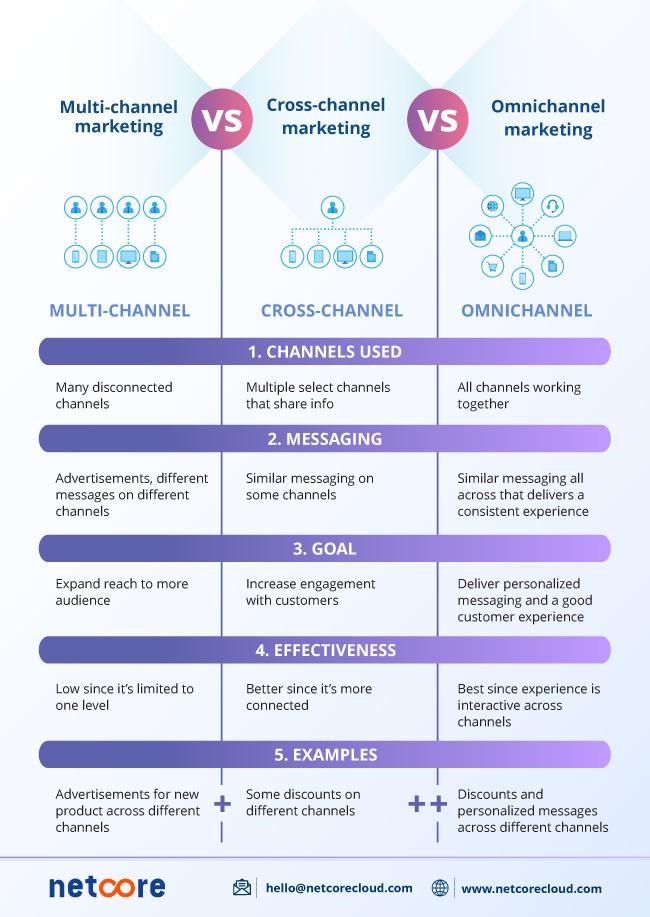
Multichannel marketing
In multichannel marketing, all the channels operate separately by the brand but are not integrated into a common sales funnel. The customer has access to content from all the different channels, which expands the brand’s reach. But the different channels may not share a consistent customer experience (for example, disconnected brand aesthetics or dissimilar messaging).
Multichannel marketing utilizes ‘many’ marketing channels but in a disjointed manner such that there is no funnel to nurture the user’s journey. It generally relies on one main message + CTA on many channels.
The goal here is to take the customer from Point A to Point B. Take a flash sale announcement, for example. You’d run advertisements on your social media platforms, emails, and SMS to drive the users at the same stage to your website.
Cross-channel marketing
Cross-channel marketing is an upgrade to multichannel marketing as multiple channels still exist. With one difference—the channels no longer exist in isolation and now share information with each other.
In cross-channel marketing, selected channels work in sync to create a uniform user experience. How? The transparency and accessibility of data flow depend on the channels used. Plus, cross-channel marketing delivers consistent messaging, which can switch from user-centric to company-centric (and vice-versa) depending on the channels.
Here marketers can reach customers across different channels, and the purpose is to continue engaging the customer across the channels throughout all customer stages. It is more connected and consistent than multichannel marketing but less personalized and user-centric than omnichannel marketing. While the end goal of multichannel and omnichannel marketing is to increase reach and deliver personalized communication, respectively, cross-channel marketing focuses on improving engagement.
For example, cross-channel marketing may include showing a sneak peek of the product on Instagram, asking the users to get on the waitlist, and finally revealing the details on email to the waitlisted users first.
Omnichannel marketing
Omnichannel marketing means a seamless connected marketing experience across all channels such that with each interaction (on different channels), the user heads towards a specific goal.
Unlike multichannel marketing, where the focus is on a single message + CTA on many channels, omnichannel marketing uses different but connected (and personalized) messaging for different user stages. Omnichannel marketing is user-centric and leverages personalization to the fullest, which is much more impactful in current times where people use multiple digital devices.
For example, your website recommended personalized products, but the user didn’t buy them, so the browser sent push notifications with offers. Now the user added the products in the cart but forgot to buy, so you send personalized emails to remind them of their abandoned cart.
7 steps to create an omnichannel marketing strategy
Now that we understand why omnichannel marketing takes the lead, let’s dive into the steps to create a robust omnichannel marketing strategy.
1. Prioritize customer experience
While a customer-centric marketing approach is becoming the norm, it is easier said than done. To begin with, you need to understand how each section in your marketing department is working and how it affects the customer experience. Omnichannel marketing blurs the line between the channels and creates a cohesive customer experience. And, for the organization, it makes you understand the role of collaboration to achieve the same goal.
Also, targeted ads and constant selling across platforms is not the best customer experience. You improve customer experience by delivering a mix of value and promotional content in a personalized, contextual, optimized manner.
The primary step is to understand all channels plus user behavior across channels. And then creating the user flow that acknowledges the customer journey and previous touchpoints.
2. Make data-backed decisions
The next step of creating an omnichannel marketing strategy involves creating a unified database that stores customer information collected from the different channels (CRM, user’s search behavior, social listening data). The data will help you understand customer behavior and interactions with the brand. It will also help you know their needs, wants, goals, preferences, such as the time of the day in which they interact the most with your brand, their preferred devices, the product they most engage with, and more. This database then becomes the foundation for building your omnichannel marketing.
However, collecting and storing data serves no purpose unless it is organized. You need an appropriate data analytics team plus tools to distill and convert unorganized data into valuable insights. Furthermore, data collection and processing should happen in real time to help you make changes to ongoing campaigns that help meet your target audiences’ expectations.
3. Choose the right marketing tools
There are many moving parts to an omnichannel marketing strategy. Therefore, to make your marketing department more efficient, you need to rely on the right tools. The tools can be divided into three categories—Customer Data Platform, Marketing stack (customer engagement/delivery channels, recommendations, etc.), and Customer Relationship Management software.
Customer Data Platform (CDP)
The CDP will be different for different organizations, but the structure is similar. Your CDP is dependent on your CRM and marketing stack to collect and provide data. Conversely, marketing stack and CRM systems will depend on the CDP’s data insights to target customers effectively. The CDP creates a database connected to all the receiving and transmitting data channels. Once the data is stored, the brand’s data analysis team can identify particular customer behaviors.
Customer Relationship Management (CRM)
CRM is also a vital component of omnichannel marketing. The companies’ salespeople access CRM software to gather customer information before making their sales pitch. Customer service and support hotlines also use CRM.
Marketing stack (customer engagement, delivery channels, recommendations)
Once the AI identifies a pattern in the customer’s interaction and behavior, it will work with the marketing stack to create triggers to launch the messages in campaigns. This enables the brand to send the right message at the right time to their potential customers. The marketers can also target the customers based on their position in the sales funnel.
4. Segmentation
Segmentation allows you to send more relevant emails and ads to your consumer. Divide the customers into segments like location, age, behavior, and demographics. These demographics are more than enough to create a tightly-knit omnichannel marketing strategy. You can also use segments in an overlapping manner for finer targeting.
5. Contextually correct and optimized messages
Contextually correct and optimized messages are personalized and relevant messages sent via the right channel at the right time (where and when users are most active).
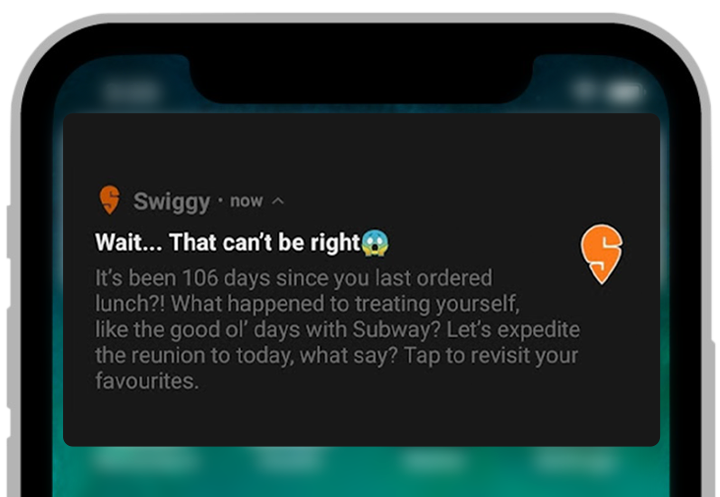
Food discounts sent during lunch hours are a great example of contextually correct messages. Optimized messages are messages sent via an optimal channel at the optimal time—where and when the users are most likely to engage.
6. Leverage artificial intelligence
To implement all that’s discussed and more, the brand needs to hire experts that can run campaigns, leverage data, and make dynamic changes as and when required. That is significant manual work. AI takes this load off you and makes manual processes efficient.
It will efficiently make dynamic adjustments to the marketing strategies to optimize customer journeys. This way, brands can also increase profitability by minimizing their cost of operations.
Netcore’s Raman AI engine is one such AI solution to drive intelligence to your omnichannel marketing campaigns and thoroughly understand what is happening? Why is it happening? And what to do next.
5 examples of omnichannel marketing
Let’s now see proficient omnichannel marketing in action as we go through how Crocs does it.
1. Web message
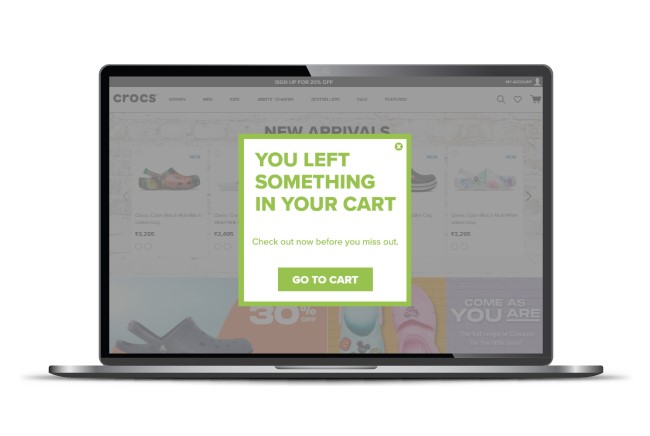
Here’s an example of an omnichannel web message. Crocs has leveraged web messages to nudge the users to check out and not abandon the cart.
2. Web push notifications
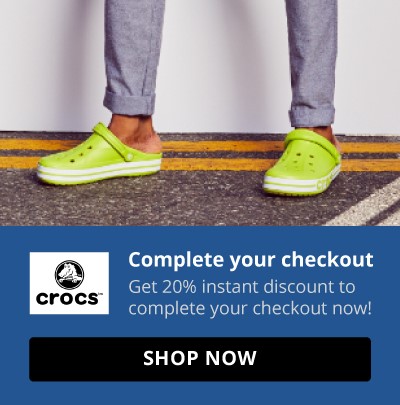
Omnichannel marketing also involves showing discounts on web push notifications either on the same or different sites.
3. Emails
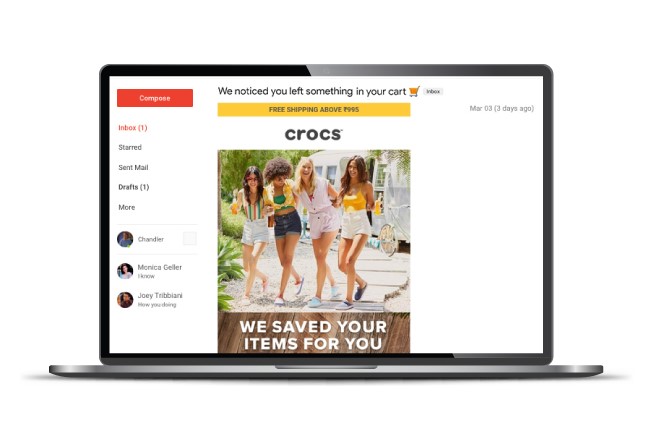
Here’s an example of omnichannel email marketing where Crocs again reminds the users of their abandoned cart and nudges them to check out. Automated email campaigns are automatically triggered based on the customer’s behavior. For example, cart abandonment emails are sent to the customer if they add items to their cart and exit the website before completing the purchase.
4. In-app messages
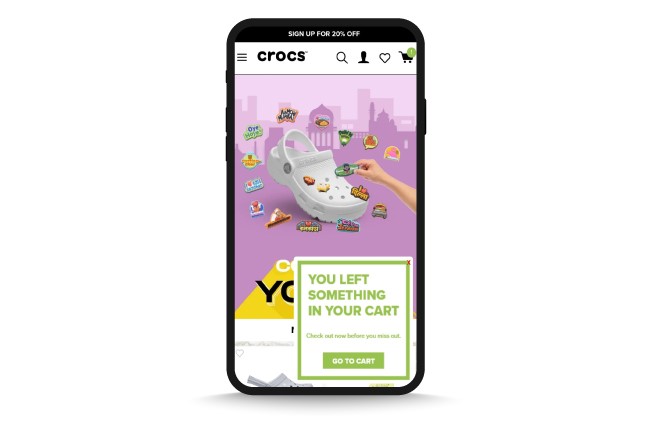
Using in-app messages, here Crocs reminds the users of their abandoned cart. The in-app message directs them to the cart and nudges them to check out.
5. SMS
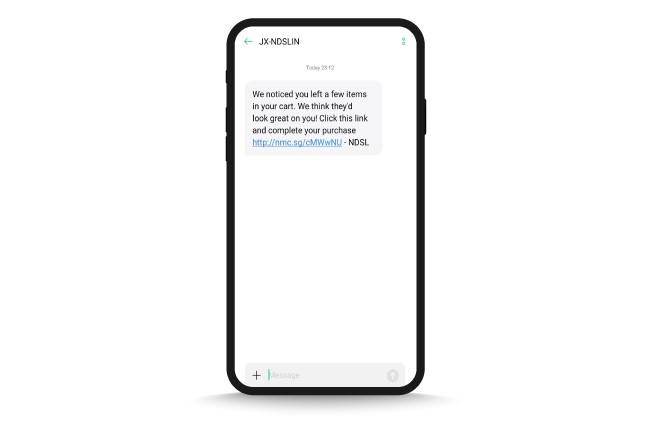
Crocs uses omnichannel SMS marketing here to direct users to their abandoned cart and nudges them to complete the purchase.
Omnichannel marketing case studies
Omnichannel marketing can create staggering results. However, marketers can get hesitant due to costs and that you require the right tech and resources to maximize its potential. That’s where full-stack marketing platforms like Netcore come in.
Netcore helped Crocs and Vero Moda, including other leading brands, leverage the potential of omnichannel marketing, and the results were spectacular.
Crocs India achieves 42X ROI with omnichannel marketing
Automated campaigns triggered to engage with the right customer at the right time across touchpoints like Website, Emails, Web Messages, and Web Push Notifications generated an ROI of 4200% for Crocs India. The clickthrough rate on the product listing page was doubled. Around 11% of the products purchased were through the personalization of marketing channels. And a third of the revenue was generated through customer engagement.
Vero Moda increases its ROI by 18X with omnichannel marketing
Engaging the right customer at the right time across channels generated a marketing ROI of 18X for Vero Moda. The items added to the cart through the products listing page saw an increase of 159%, and the increase in the purchase rate of products on the listing page was around 121%. Overall, omnichannel marketing contributed to 6.7% of the total revenue.
Key benefits of omnichannel marketing
Here’s how your brand can expand after implementing omnichannel marketing the right way.
Better customer relationship, experience, and insight
Omnichannel marketing strategy efficiently nurtures the customer’s relationship with the brand. This form of marketing consistently hits all the customer touchpoints in a personalized manner. And most importantly, it shows relevant messages at the optimal channels as opposed to spamming ads all across. That creates a better customer experience and eventually increases the chances of repeat purchases.
Also, understanding the ins and outs of customer behavior across your sales funnel will significantly improve conversion and eliminate drop-outs.
And excellent customer experience = increased brand loyalty.
More revenue
Personalized recommendations show products that people want to purchase.
Omnichannel marketing also increases the brand’s revenue as the customers are more likely to re-engage with the brand through various channels.
Higher customer retention
You are most likely to retain customers when you deliver a good customer experience and engagement via different channels. Brands using omnichannel marketing strategies retain 89% of their customer base compared to other strategies.
Is omnichannel marketing worth the investment?
We saw some compelling factors to steer the newer brands towards indulging in this ‘seemingly’ complex strategy. However, omnichannel marketing offers an unmatched customer experience and makes them feel understood. The messages, notifications, emails, and social media ads are a mix of promotional sales and content that adds value to the customers’ experience.
Omnichannel marketing delivers exponential results with high probability, like 42x ROI for Crocs.
You don’t have to start big and integrate all the channels at once. Start by incorporating a few channels and comparing the results with previous marketing campaigns. Even 2 or 3 channels working together can increase the purchase rate by 287%.
Netcore’s Cloud’s customer engagement platform has the infrastructure and the expertise to set up your omnichannel marketing channels and get them running within a few weeks. Our ability lies in creating diverse journeys and reaching customers effectively across channels. Netcore helps your brand reach the right customers, with the right message, at the right time, know more here.










